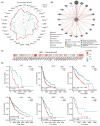HSF1 Activation Mechanisms, Disease Roles, and Small Molecule Therapeutics
- PMID: 40520012
- PMCID: PMC12160081
- DOI: 10.7150/ijbs.110447
HSF1 Activation Mechanisms, Disease Roles, and Small Molecule Therapeutics
Abstract
The heat shock factor 1 (HSF1) is a master transcription regulator that orchestrates the expression of heat shock proteins (HSPs) in response to various cellular stresses. Dysfunction of HSF1 contributes to the pathogenesis of a spectrum of acute and chronic diseases, including cancer. Consequently, the modulation of HSF1 activity through the development of small molecules emerges as a promising therapeutic strategy for disease treatment. The activation of HSF1 is a multifaceted process, governed by a complex interplay of regulatory mechanisms, including post-translational modifications, protein-protein interactions, and a balance between its activation and inactivation. Recently, a plethora of compounds, ranging from synthetic to naturally derived, that either inhibit or activate HSF1 was identified, holding considerable potential for the treatment of numerous human diseases. In this comprehensive review, we elucidate the sophisticated mechanisms underlying activation of human HSF1, introduce its role in the etiology of diseases, and provide a comprehensive summary of the inhibitors and activators of HSF1 that have been discovered to date. This review not only offers novel insights for the development of small molecule therapeutics targeting HSF1 but also charts new territories in the design of innovative interventions for the amelioration of disease.
Keywords: HSF1; activators; cancer; inhibitors; therapeutic strategy.
© The author(s).
Conflict of interest statement
Competing Interests: The authors have declared that no competing interest exists.
Figures



Similar articles
-
Targeting HSF1 for cancer treatment: mechanisms and inhibitor development.Theranostics. 2023 Apr 17;13(7):2281-2300. doi: 10.7150/thno.82431. eCollection 2023. Theranostics. 2023. PMID: 37153737 Free PMC article. Review.
-
Small Molecule Inhibitors of HSF1-Activated Pathways as Potential Next-Generation Anticancer Therapeutics.Molecules. 2018 Oct 24;23(11):2757. doi: 10.3390/molecules23112757. Molecules. 2018. PMID: 30356024 Free PMC article. Review.
-
Inhibiting Heat Shock Factor 1 in Cancer: A Unique Therapeutic Opportunity.Trends Pharmacol Sci. 2019 Dec;40(12):986-1005. doi: 10.1016/j.tips.2019.10.008. Epub 2019 Nov 11. Trends Pharmacol Sci. 2019. PMID: 31727393 Review.
-
Comparative interactomes of HSF1 in stress and disease reveal a role for CTCF in HSF1-mediated gene regulation.J Biol Chem. 2021 Jan-Jun;296:100097. doi: 10.1074/jbc.RA120.015452. Epub 2020 Nov 24. J Biol Chem. 2021. PMID: 33208463 Free PMC article.
-
HSF1 as a Cancer Biomarker and Therapeutic Target.Curr Cancer Drug Targets. 2019;19(7):515-524. doi: 10.2174/1568009618666181018162117. Curr Cancer Drug Targets. 2019. PMID: 30338738 Free PMC article. Review.
Cited by
-
The Rapid Activation of MYDGF Is Critical for Cell Survival in the Acute Phase of Retinal Regeneration in Fish.Int J Mol Sci. 2025 Jul 27;26(15):7251. doi: 10.3390/ijms26157251. Int J Mol Sci. 2025. PMID: 40806387 Free PMC article.
References
-
- Richter K, Haslbeck M, Buchner J. The heat shock response: life on the verge of death. Molecular cell. 2010;40:253–66. - PubMed
-
- Nakai A. Heat shock factor: Springer; 2016.
-
- Wang N, Ma H, Li J, Meng C, Zou J, Wang H. et al. HSF1 functions as a key defender against palmitic acid-induced ferroptosis in cardiomyocytes. Journal of molecular and cellular cardiology. 2021;150:65–76. - PubMed
Publication types
MeSH terms
Substances
LinkOut - more resources
Full Text Sources

